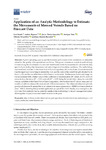Application of an Analytic Methodology to Estimate the Movements of Moored Vessels Based on Forecast Data

View/
Use this link to cite
http://hdl.handle.net/2183/34881Collections
- Investigación (ETSECCP) [827]
Metadata
Show full item recordTitle
Application of an Analytic Methodology to Estimate the Movements of Moored Vessels Based on Forecast DataAuthor(s)
Date
2019-09Citation
Sande, Figuero, Tarrío-Saavedra, Peña, Alvarellos, y Rabuñal, «Application of an Analytic Methodology to Estimate the Movements of Moored Vessels Based on Forecast Data», Water, vol. 11, n.o 9, p. 1841, sep. 2019, doi: 10.3390/w11091841.
Abstract
[Abstract]: A port’s operating capacity and the economic performance of its concessions are intimately related to the quality of its operational conditions. This paper presents an analytical methodology for estimating the movements of a moored vessel based on field measurements and forecast data, specifically including ship dimensions and meteorological and maritime conditions. The methodology was tested and validated in the Outer Port of Punta Langosteira, A Coruña, Spain. It was determined that the significant wave height outside the port, and the ratio of the vessel’s length divided by its beam (L/B), are the variables that most influence movements. Furthermore, heave and surge are the movements with a better value of the coefficient of determination (R2 values of 0.71 and 0.67, respectively), the sway (R2 = 0.30) and roll (R2 = 0.27) being the worst when using the available forecast variables of the Outer Port of Punta Langosteira. Despite their low R2 values, sway and roll models are able to estimate the main trends of these movements. The obtained estimators provide good predictions with assumable error values (root mean square error—RMSE and mean absolute error—MAE), showing their potential application as a predictive tool. Finally, as a consequence, the A Coruña Port Authority has included the results of the methodology in its port management system allowing them to predict moored vessel behavior in the port.
Keywords
In-situ observations
Port operation
Transfer functions
Meteorological and ocean conditions
Vessel dimensions
Port operation
Transfer functions
Meteorological and ocean conditions
Vessel dimensions
Editor version
Rights
Atribución 3.0 España
ISSN
2073-4441






